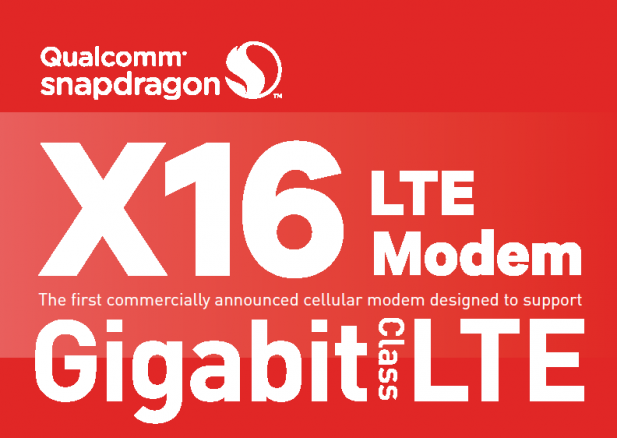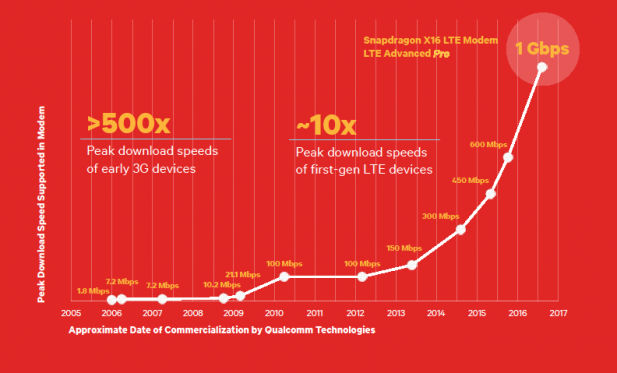Qualcomm continues to set new standards for LTE modem performance today with the announcement of its X16 Gigabit Class LTE modem. Of course when Qualcomm says Gigabit what they really mean is an honest 1 Gbps down but that’s close enough that we’re willing to round-up. The X16 modem achieve a near doubling in peak download speed compared to the its previous offering the X12 which could only manage a mere 0.6 Gbps. This gain comes thanks to a triple threat of technologies from Qualcomm: better signal processing to extract more data from the same signals, more LTE streams through a 4×4 MIMO setup, and the use of unlicensed spectrum for LTE transmissions.
UPDATE 2/11/2015 @ 1:44 PM PST: Qualcomm has confirmed that the X16 modem does not top out at 0.98 Gbps, but rather actually does hit the 1 Gbps mark. The 0.98 number cited above was from our briefing with Qualcomm a few months ago.
The X16 LTE modem implements Qualcomm’s 256-QAM (quadrature amplitude modulation) for downlink transmissions. This is a signal processing technique that helps the modem get more data from the same signal stream. Using a 4×4 MIMO configuration and up to 10 data streams the X16 is able to achieve gigabit speeds by offer more data transmission streams than any other LTE modem.
And with the ability to use unlicensed spectrum to carry LTE signals thanks to LTE-U you have a somewhat reasonable chance of being able to see Gigabit speeds in the real world without massive upgrades to the existing cellular networks in the U.S. In fact, Qualcomm thinks that by 2017 more than half of the carriers worldwide will support Gigabit LTE modems thanks to LTE-U and the international version of that standard dubbed LAA or License Assisted Access.
Qualcomm is hoping that OEMs will pair its new X16 modem with its new single-chip digital RF Transceiver the WTR5975 which enables all of the advanced features of the X16 modem and has a smaller foot print on the device’s PCB than prior solutions. In addition to this transceiver Qualcomm is also promoting its RF360 QET4100 Envelope Tracker which works to actively improve the signal quality of LTE connections and reduce the transmission power required for a given data stream.
All three of these chips are sampling now to interested parties and Qualcomm believes that we’ll start seeing devices integrating its new modem stack sometime in the latter half of this year.
The only place where this X16 modem doesn’t move things forward is in uplink speeds which remain the same as last year’s X12 modem at 0.15 Gbps. We questioned Qualcomm on this point and learned that the company doesn’t believe that pushing for higher upload speeds on its LTE modems is a good investment at this time due to a lack of existing cellular infrastructure that could actually support higher uplink data rates. If the networks can’t support it, and aren’t planning on building support for it, then Qualcomm’s not going to waste silicon on it. This seems like a reasonable position for the company to hold.
Perhaps one of the more interesting properties of this X16 modem is that it’s being built on a bleeding edge 14nm FinFET process by Samsung’s foundry group. Although it’s not uncommon to see modems built on state-of-the-art process nodes it is interesting to see Qualcomm offering 14nm products so early in the life span of the node.
In the end Qualcomm has announced another neat product today and in the process reminded everyone of their dominance in the LTE modem market yet again. Gigabit LTE modems will be here soon and given that similar speeds are just starting to be rolled out across the U.S. thanks to a recent push for fiber installations by companies like Google Fiber and CenturyLink here’s to hoping that we’ll soon see more competition between traditional wired ISPs and Wireless Carriers.S|A
Thomas Ryan
Latest posts by Thomas Ryan (see all)
- Intel’s Core i7-8700K: A Review - Oct 5, 2017
- Raijintek’s Thetis Window: A Case Review - Sep 28, 2017
- Intel’s Core i9-7980XE: A Review - Sep 25, 2017
- AMD’s Ryzen Pro and Ryzen Threadripper 1900X Come to Market - Aug 31, 2017
- Intel’s Core i9-7900X: A Review - Aug 24, 2017

